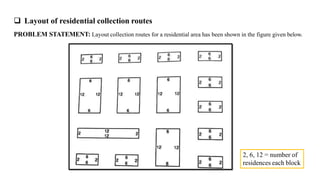Route optimization.pptx
- 1. ïą Layout of residential collection routes PROBLEM STATEMENT: Layout collection routes for a residential area has been shown in the figure given below. 2, 6, 12 = number of residences each block
- 2. The service area map would be prepared as the first step in the layout of collection routes. Assume that the following conditions apply: 1. General i. Occupants per residence = 3.5 ii. Solid waste collection rate = 1.6 kg/capita.d iii. Collection frequency = once/week iv. Type of collection service = curb v. Collection crew size = one person vi. Collection vehicle capacity = 20 m3 vii. Compacted specific weight of solid waste in collection vehicle = 325 kg/m3 2. Collection route constraints a) No U-turn in streets. b) Collection from each side of the street with stand-up right hand-drive collection.
- 3. SOLUTION 1. Development of data needed to establish collection routes a) Determination of total number of residences from which wastes are to be collected Residences = 10 (16) + 4(36) + 1(28) = 332
- 4. Volume per week = a) Determination of the compacted volume of solid waste to be collected per week [( Residences à occupants per residence à solid waste collection rate) à 7 d/wk] Compacted specific weight of solid waste in collection vehicle Trip/wk = [(332 residences à 3.5 persons/residence à 1.6 kg/capita . d) à 7 d/wk] = 325 kg/m3 = 40.0 m3 b) Determination of the number of trips required per week Compacted volume of solid waste collected per week = = 2 Collection vehicle capacity per week 40.0 20
- 5. âĒ Determination of the average number of residences from which wastes are to be collected on each collection trip âĒ Residences/trip = 332/2 =166 âĒ Layout collection routes by successive trials using the route constraints cited above as a guide. Start route 1 Start route 2 End route 1 End route 2 ADDITIONALCOMMENT: The effectiveness of the collection routes can be assessed by the amount of route overlap shown by the dotted lines.



![Volume per week =
a) Determination of the compacted volume of solid waste to be collected per week
[( Residences à occupants per residence à solid waste collection rate) à 7 d/wk]
Compacted specific weight of solid waste in collection vehicle
Trip/wk =
[(332 residences à 3.5 persons/residence à 1.6 kg/capita . d) à 7 d/wk]
=
325 kg/m3
= 40.0 m3
b) Determination of the number of trips required per week
Compacted volume of solid waste collected per week
=
= 2
Collection vehicle capacity per week
40.0
20](https://image.slidesharecdn.com/routeoptimization-220907074627-a433b97f/85/Route-optimization-pptx-4-320.jpg)
